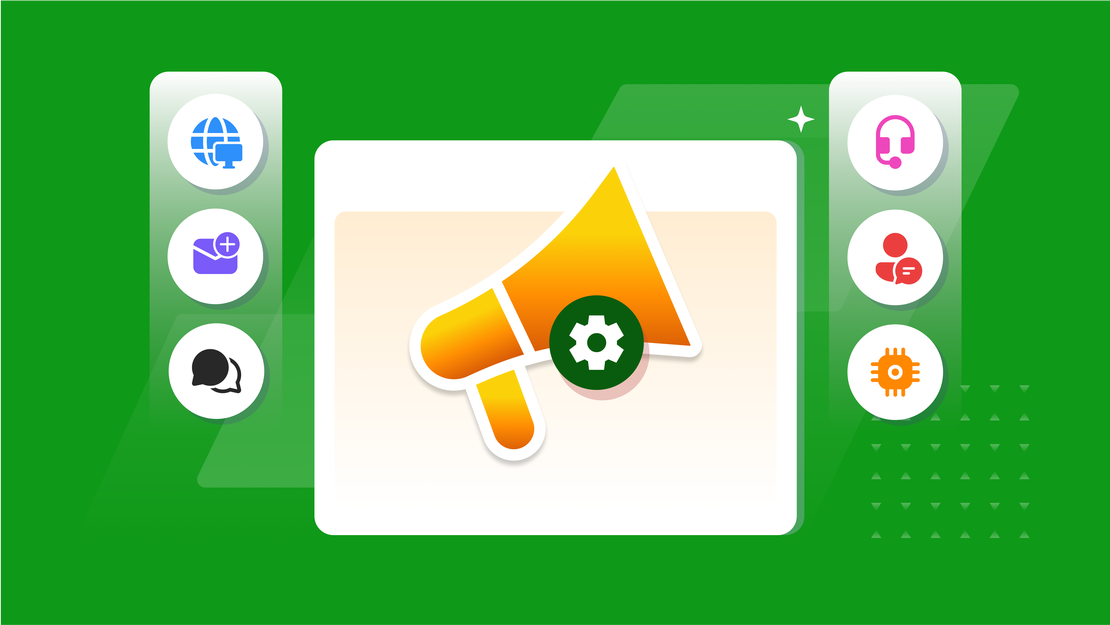6 Personalization Strategies for Marketing
Consumers expect personalized attention. They want to feel that a brand understands them and thinks with them. And the numbers don’t lie: 91% of consumers are more likely to buy from brands that provide relevant offers and recommendations.
McKinsey research shows that companies that deploy personalization using AI can increase sales by 10 to 20%. And a report by Epsilon shows that 80% of consumers are more likely to buy something from a brand that offers personalized experiences.
In this article, we explain the meaning of personalization and we’ve listed the 6 most effective personalization strategies. Strategies that will help you engage customers, gain their trust, and increase your conversion rate.

Table Of Contents
Meaning of personalization
But first, what is the meaning of personalization? It is tailoring something to a person’s characteristics, preferences or needs. It comes from the word “personalize”.
Personalization examples:
- In marketing: you get to see personalized ads based on your previous search behavior or interests
- In technology: an app or website adapts to your preferences, such as language, theme or previously viewed content
- In education: learning materials are adapted to the level or learning style of the student
- In customer service: you are addressed by your name and get help based on your purchase history
6 Personalization strategies for communication and marketing
So how can you get started with personalization without making it too complex? We’ll explain 6 strategies that are easy to implement–especially if you work with a CRM system.
A CRM system is essential to collect all the data you need to personalize your communication and marketing, as well as to automate it. Try our CRM system now for free and sign up for our BETA Program.
1. Dynamic content on your website
Your website gets all kinds of visitors. Suppose you run a web shop for sporting goods. That attracts all kinds of people: runners, tennis players, yogis, swimmers. With dynamic content, you can automatically tune the content to the visitor.
Based on cookies or login information, your website recognizes that a runner is visiting. Then, for example, the homepage can immediately show new running shoes and a blog post about endurance training. The running category is at the top of the menu. And a pop-up shows that he gets a 10% discount on special running socks.
This way, the visitor does not have to search for as long and is much more likely to buy something than a standard homepage.
2. Personalized communication via email
Email remains one of the most powerful channels for personalization. And it goes beyond just the first name in the salutation. Consider:
- Recommended products based on previous purchases
- Follow-ups based on click behavior
- Abandoned cart emails tailored to the product abandoned
Segmentation plays a key role here. By splitting your mailing lists into smaller groups based on behavior or preferences, you can communicate in a much more targeted way. According to Campaign Monitor, personalized emails generate 6 times more sales than generic emails.
3. Personalized customer service
A customer who feels understood stays longer and buys more. Personalize your customer service by using customer data smartly. For example:
- Recognize repeat customers and reference previous purchases or questions
- Use CRM data to factor preferences or previous feedback into the conversation
- Give employees access to relevant customer data so they can respond more quickly and personally
Research shows that 66% of customers expect companies to understand their unique needs. With a good CRM system, you can make great strides quickly.
4. Live chat support with context
Live chat is wildly popular––especially among younger audiences. But standard answers are counterproductive. Customers expect to be helped immediately by someone who understands their situation.
Advanced chat tools automatically display information about the customer: what pages they have visited, what they have in their shopping cart or whether they have had previous contact. According to Drift, 79% of companies with live chat believe it enhances their customer loyalty.
By personalizing live chat:
- You reduce wait time and frustration
- Increase trust in your brand
- Improve your customer satisfaction and conversion rate
5. Polite, human communication
Personalize not only by data, but also by feel. Customers don’t want robotic answers or standard formulations. This means:
- Write as you talk (friendly, warm, jargon-free)
- Show empathy in your responses: “We’re sorry that this happened, I would be happy to help you”
- Make sure your tone of voice suits the target audience: young and informal, or conversely professional and businesslike
Especially for SME entrepreneurs, this is a powerful weapon: you are your brand. The more personal and sincere you communicate, the stronger the bond with your customers.
6. AI-driven recommendations
Those looking to scale up can gain a lot with AI. Think of tools that automatically make personalized recommendations:
- Web shops show products based on click behavior and previous purchases
- Blogs suggest articles that match reading behavior
- AI-based email tools automatically determine which type of content best suits each recipient
According to Accenture, 91% of consumers are more likely to store with brands that provide relevant offers and recommendations. And with AI, this process is becoming easier and more scalable.
Summary: The meaning of personalization
Personalization means addressing your customers or stakeholders in a personal, relevant way. Personalize your communications not just because you have to, but because it works. Because by putting your customer first, you build a stronger relationship––and you increase your sales. That is the true meaning of personalization!